-
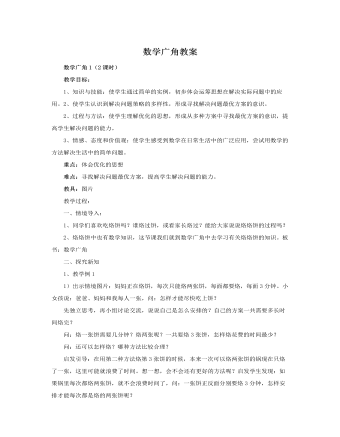
人教版新课标小学数学四年级上册数学广角教案
教学目标:知识与技能:1、使学生初步体会对策论方法在解决实际问题中的应用。2使学生认识到解决问题策略的多样性,形成寻找解决问题最优方案的意识。3、培养学生的应用意识和解决实际问题的能力。过程与方法:使学生理解优化的思想,形成从多种方案中寻找最优方案的意识,提高学生解决问题的能力。情感、态度和价值观:使学生感受到数学在日常生活中的广泛应用,尝试用数学的方法解决生活中的简单问题。重点:体会优化的思想难点:寻找解决问题最优方案,提高学生解决问题的能力。教具:图片教学过程:一、情境导入:1、你们听过“田忌赛马“的故事吗?田忌是怎样赢了齐王的?谁能给大家讲一讲这个故事?2、问:田忌的马都不如齐王的马,但他却赢了?这是为什么呢?3、这节课我们就来研究研究。板书课题:数学广角
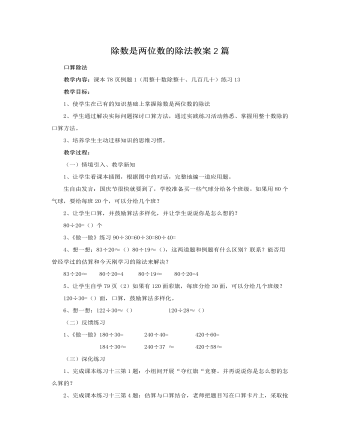
人教版新课标小学数学四年级上册除数是两位数的除法教案2篇
教学目标:1、使学生在已有的知识基础上掌握除数是两位数的除法2、学生通过解决实际问题探讨口算方法,通过实践练习活动熟悉、掌握用整十数除的口算方法。3、培养学生主动迁移知识的思维习惯。教学过程:(一)情境引入、教学新知1、让学生看课本插图,根据图中的对话,完整地编一道应用题。生自由发言:国庆节很快就要到了,学校准备买一些气球分给各个班级。如果用80个气球,要给每班20个,可以分给几个班?2、让学生口算,并鼓励算法多样化,并让学生说说你是怎么想的?80÷20=()个3、《做一做》练习90÷30=60÷30=80÷40=4、想一想:83÷20≈()80÷19≈(),这两道题和例题有什么区别?联系?能否用曾经学过的估算和今天刚学习的除法来解决?

人教版新课标小学数学四年级上册大数的认识教案
教学建议:亿以内数的读法是在万以内数的认识基础上进行教学的,主要是让学生用已有的知识去类推,所以在教学本课时我们有必要对万以内数的认识进行有针对性的复习。如可采用口答形式复习数位顺序及各数位之间的十进关系。对于万以内数的读法,可以出示一组数据如:2005年路桥区前两个月共实现农林、渔业总产值17013万元,其中农业产品6383万元,林业产值94万元,渔业产值7560万元。在对万以内数复习的基础上我们再出示第2页主题图,让学生读一读画面上呈现的6个大数,也可以让学生说说身边听到,看到的大数。在这环节中我们就让学生凭着自己的理解运用旧知识去读数。这里学生肯定会造成认知上的冲突,从而引入新课教学。新课时可以按以下环节进行:1、计数器操作,认识计数单位用计数器数数,拨上一万,然后一万一万地数,一直数到九万后,再加一万是多少?认识十个一万是十万,用同样的方法,完成一百万,一千万,一亿的认识。
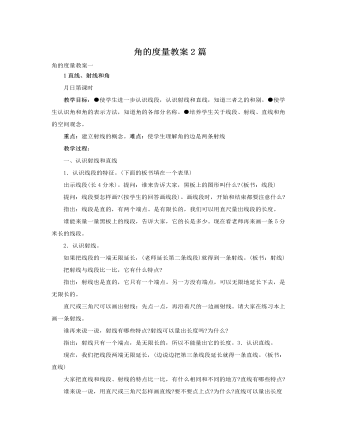
人教版新课标小学数学四年级上册角的度量教案2篇
一、认识射线和直线1.认识线段的特征。(下面的板书填在一个表里)出示线段(长4分米)。提问:谁来告诉大家,黑板上的图形叫什么?(板书:线段)提问:线段要怎样画?(按学生的回答画线段)。画线段时,开始和结束都要注意什么?指出:线段是直的,有两个端点。是有限长的,我们可以用直尺量出线段的长度。谁能来量一量黑板上的线段,告诉大家,它的长是多少。现在看老师再来画一条5分米长的线段。2.认识射线。如果把线段的一端无限延长,(老师延长第二条线段)就得到一条射线。(板书:射线)把射线与线段比一比,它有什么特点?指出:射线也是直的,它只有一个端点。另一方没有端点,可以无限地延长下去,是无限长的。直尺或三角尺可以画出射线:先点一点,再沿着尺的一边画射线。请大家在练习本上画一条射线。
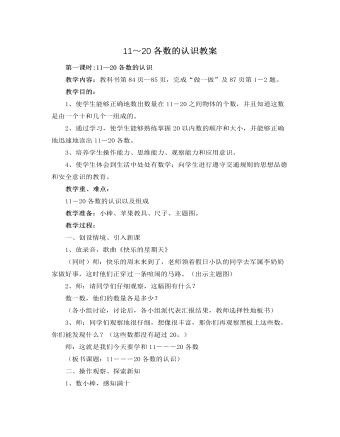
人教版新课标小学数学一年级上册11~20各数的认识教案
教学难点:能用多种方法进行计算。教学准备:计数器、小棒、投影片等。教学过程:一、创设情景(投影出示)在一个美丽的大森林里,一天早上,二只松鼠提着一个篮子上山采松果,松鼠妈妈采了14个,松鼠宝宝采了3个,然后就一起高高兴兴地回家去了。(学生看图,然后让学生根据图意编一个小故事,比一比,看谁编的故事最有趣)1、指名编故事。2、有谁能提出有关的数学问题。(先同桌互相说,然后再指名说)教师根据学生的回答进行选择性的板书:(1)一共有多少个松果?(2)松鼠妈妈比松鼠宝宝多采多少个?(3)松鼠宝宝比松鼠妈妈少采多少个松果?(4)松鼠宝宝还要采多少个才能和松鼠妈妈采的同样多?3、先解决第一个问题:问:(1)要求一共有多少个松果?用什么方法计算?如何列式?为什么用加法计算?说一说你的理由?还有谁能说?(2)14+3=?你是怎样算的?同桌互说算法,然后指名说。
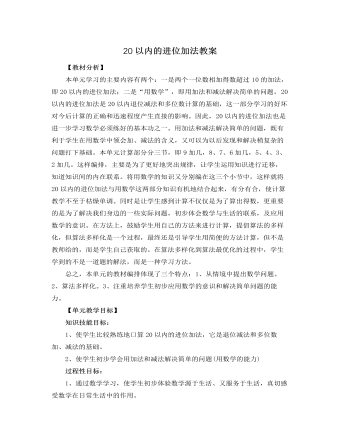
人教版新课标小学数学一年级上册20以内的进位加法教案
教学目标:1、通过多种形式的练习,提高学生的计算速度和正确率。2、培养学生看图表的能力,初步渗透统计思想。3、培养学生学习数学的兴趣,同时培养学生的数感。教学重、难点:熟练掌握计算方法并能够进行正确的计算,能够有效的提高计算速度及正确率教学过程:一、基本练习1、口算10-38+49-1 9-88+215+38+77+55+6 3+911-19+68+86+78+6 9+82+93+102、()里应填什么数?(1)比9大2的数是(),比7多4的数是()。(2)写出得数是13的四道算式?( )、()、( )、()(3)练习9+()=13 8+()=1512-()=2()+7=14()+()=12 ()+()=19二、指导练习练习二十一第4题(1)学生看书,弄清题目的意思。问:这题是什么意思?(2)分组讨论,并派代表说一说。(3)教师板书,引导学生看统计表。指导学生看表:表的第一竖行画有皮球、毽子、跳绳;第二竖行上面写着“一班有”,下面的数就是一班有这三种体育用品的数量,即一班有7个皮球、5个毽子、4条跳绳;
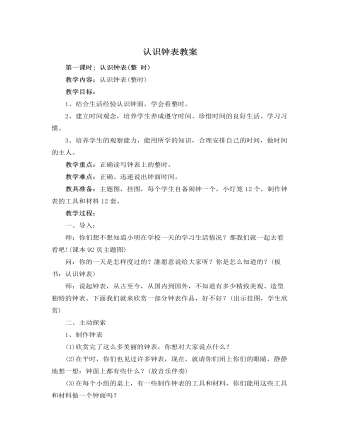
人教版新课标小学数学一年级上册认识钟表教案
二、认识半时1、挂图出示钟面:7时半、8时半师:请小朋友拿出自己的钟,拨一拨这二个钟面上所表示的时刻,你能发现这两个钟面有什么共同的特点吗?2、学生自由回答。教师小结,得出规律:钟面上半时时,分针指着数字6,而时针总是指向两个数字的中间。挂图再出示二个钟面上的表示的时刻,师:你说一说这两个钟面的时刻是多少3、认一认挂图出示图片(即书中第93面的做一做)师:请你说一说图中的小朋友,几时在干什么?4、挂图出示7时、7时半师:请你们认真观察,说一说这两个钟面上表示的时刻,看一看两根指针的位置有什么不同?5、教师小结。三、练习反馈,激活思维1、请你在你的钟上面拨一个你最喜欢的半点时刻,并说一说你为什么最喜欢这个时刻?
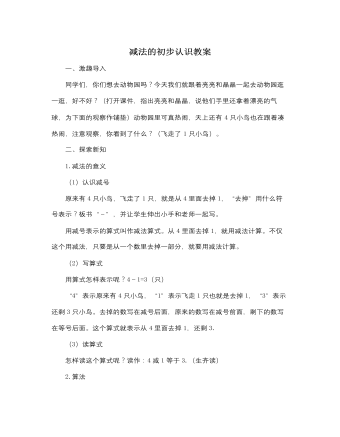
人教版新课标小学数学一年级上册减法的初步认识教案
一、激趣导入同学们,你们想去动物园吗?今天我们就跟着亮亮和晶晶一起去动物园逛一逛,好不好?(打开课件,指出亮亮和晶晶,说他们手里还拿着漂亮的气球,为下面的观察作铺垫)动物园里可真热闹,天上还有4只小鸟也在跟着凑热闹,注意观察,你看到了什么?(飞走了1只小鸟)。二、探索新知1.减法的意义(1)认识减号原来有4只小鸟,飞走了1只,就是从4里面去掉1,“去掉”用什么符号表示?板书“-”,并让学生伸出小手和老师一起写。用减号表示的算式叫作减法算式。从4里面去掉1,就用减法计算。不仅这个用减法,只要是从一个数里去掉一部分,就要用减法计算。(2)写算式用算式怎样表示呢?4-1=3(只)“4”表示原来有4只小鸟,“1”表示飞走1只也就是去掉1,“3”表示还剩3只小鸟。去掉的数写在减号后面,原来的数写在减号前面,剩下的数写在等号后面。这个算式就表示从4里面去掉1,还剩3.
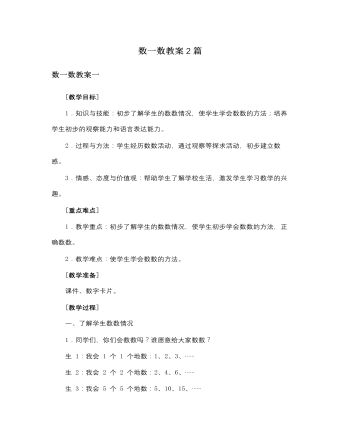
人教版新课标小学数学一年级上册数一数教案2篇
[在学生数的过程中再加强点数的指导,同时有意识的培养学生按顺序数数。另外,在数六朵花、八棵树、九名女生、十名男生的时候,除了 1 个 1 个地数以外,还可以引导学生 2 个 2 个地、3 个 3 个地、4 个 4 个地、5 个 5 个地数数,为后面学习 10 以内各数打基础。] (2)小组进行交流。 再从 1~10 数一数物体的个数。 (3)认一认。 师:你认识这些数吗?边指边读给大家听听。 生:边指 1~10 各数边读一读。 三、巩固练习 1.结合实物,开展数数活动。 (1)按要求数出下面物体的个数。 师:同学们刚才数得真不错!你们愿不愿意数一数自己文具盒中有几支铅笔呀? 生:数出自己文具盒中有几支铅笔并汇报。 师:请同学们数一数你的书包里共有几本书? 生:数出自己书包里共有几本书并汇报…… (2)自由数物体的个数。 师:你还想数哪些物体的个数?和同桌的小伙伴交流一下。
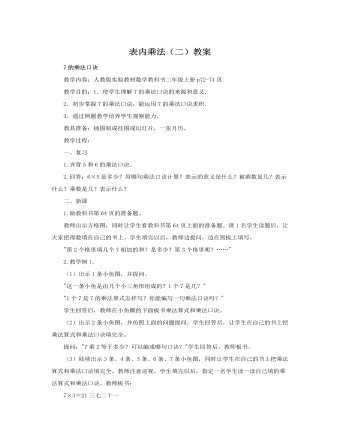
人教版新课标小学数学二年级上册表内乘法(二)教案
三、利用乘法口诀进行计算1.复习口诀的含义。任意挑出一句乘法口诀(两个因数不同的),让学生说说它表示什么意思。如"七八五十六",使学生知道它既表示8个7相加是56,又表示?个8相加是56。2.以游戏的方式开展用口诀进行计算的活动。(1)已知两个因数求积的游戏。方法是:请一位学生随意说出一个两位数,另一位学生则将这个两位数的十位数字与个位数字相乘,并算出结果,如果结果又是一个两位数,再将这个两位数的十位数字和个位数字相乘,直至结果是一位数或零。如,一位学生说:"79",另一位学生则口算:7X9=636X3=181X8=8;一位学生说:"58":另一位学生口算:5X8=404X0=0(告诉学生0和一个数相乘得零)一位学生报了3个数以后,互换角色进行。(2)已知积求两个因数的游戏。
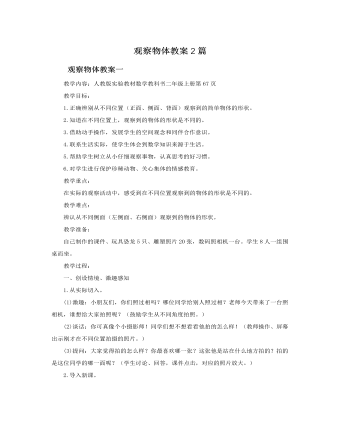
人教版新课标小学数学二年级上册观察物体教案2篇
教学过程:一、故事导入1.出示主题图配合音乐,师:“有一只蜻蜓在动物城里玩,遇到了辛勤工作的蜜蜂,看见了一座座漂亮的房屋。”蝴蝶说:“瞧。自己做了一件衣服,但是穿起来很不合身,怎么办?”(出现三种不对称的衣服图形)“于是,蝴蝶去找蜻蜓帮忙。”2.师:“一路上,蝴蝶看到许多美丽的景色,遇见许多动物朋友。瞧,美丽的孔雀走来了,还有知了、七星瓢虫、螃蟹。”3.师:“小朋友,它们美吗?你能说说你觉得它们哪儿美?(学生自由回答)那咱们把它们画下来,好吗?”二、初步感知对称图形的特点1.(指着蝴蝶形)师:“这么美的图形你想不想剪出一个来?请小朋友们拿出一张彩纸,用剪刀剪出这只蝴蝶,行吗?”(请学生说一说怎么剪的?)师:“有的小朋友剪出的蝴蝶为什么不像呢?为什么有的小朋友又能剪出美丽的蝴蝶呢?蝴蝶的形状到底有什么特点,让咱们来研究研究。”
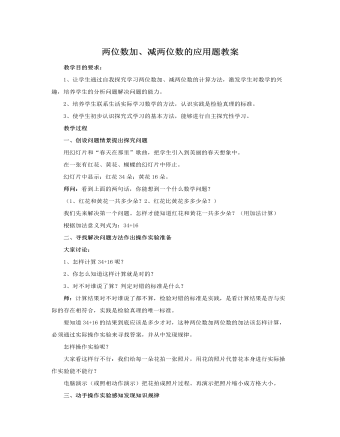
人教版新课标小学数学二年级上册两位数加、减两位数的应用题教案
1、试验性操作实验师:大家说红花的照片能不能用方格代表?下面请同学们用方格代表红花的照片,用我们的学具卡片摆出红花的朵数。(学生操作,教师巡视。)师:大家说黄花的朵数能不能也可以这样操作出?请同学们用上面的方法再操作出黄花的朵数。(学生操作)师:同学们已经摆出了红花的朵数和黄花的朵数,怎么操作才能知道红花和黄花一共是多少朵?(把红花的朵数和黄花的朵数合并起来数一数)(学生操作,教师巡视。)师:请把合并起来的数整理一下,让人一看就能知道是多少朵好吗?请同学们写出算式的答案。(即操作表达式)教师多媒体演示全部操作实验过程,并简单小结。2、验证性操作实验师:同学们,假如红花是56朵,黄花是38朵,求“红花和黄花共几朵?”你们还能不能用上面的操作实验方法来解决?(能)好!那就请你们试试看。(学生操作,教师巡视。)
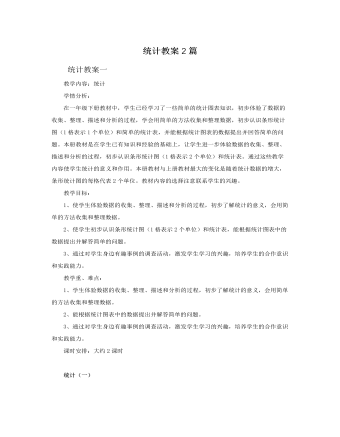
人教版新课标小学数学二年级上册统计教案2篇
1、让学生仔细观察,练习二十二1题图,你看到了什么?生:举手自由口答。2、师:根据这些信息,你能提出什么问题?板书学生提出问题在此基础上,师生重点解决问题3、小黑板出数统计表、统计图(1)学生在树上独立完成(2)上台展示并回答问题(3)师质疑:你还能提出哪些问题?[设计意图]:通过统计停车场每种车的数量,把解决问题和统计知识综合进来,巩固所学统计知识和解决问题,体验怎样收集信息。二、生活应用1、出示97页2题(1)同桌观察理解(2)独立在书上完成2、互相纠错评价,教师巡视辅导。3、质疑:你还能提出什么问题?[设计意图]:让学生通过数“正”字来收集信息。三、开放实践1、p97页3题4题(1)学生以小组为单位展开讨论统计。(1、2、3组做3题,4、5、6组做4题)(2)展示师生互评[设计意图]:让学生发挥主体性去调查收集数据,根据自己的能力提出并回答一些问题。
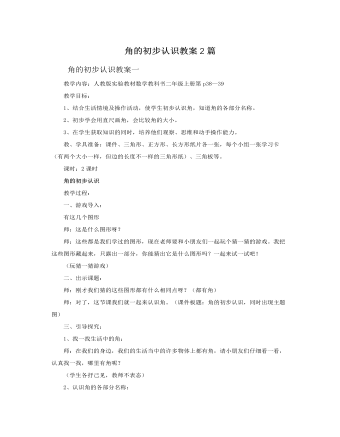
人教版新课标小学数学二年级上册角的初步认识教案2篇
【课中安排学唱《可爱的角》这首歌曲,旋律是学生熟悉并喜爱的,加上简明扼要的歌词和动作,提高了孩子们的兴趣。】四、课堂活动(课件出示)1.辨角。用你火眼金睛找出哪些是角?哪些不是角?为什么?(练习八的第1题)【在学生对角建立起概念的前提下,让学生做该练习,从而加深了学生对角的认识,增强分析、判断能力。这个练习可以叫它“跟随”练习,即刚学会一个新的概念,认识一个新的内容之后,紧跟着的一个比较容易的以选择和判断为主的练习。】2.数角(练习八的第2题)。师:小马看见小朋友们都认识了角,非常高兴,看看天色不早了,赶紧赶路,跑了一会儿,看见图形王国里面有许多图形,但小马不知道各有几个角?小朋友们能帮助它数一数吗?【这是一道“巩固”练习,让学生将所学知识做一次运用,难度稍加大,但学生能做出来,并且能找到练习中的规律,能享受到一种成就感。】
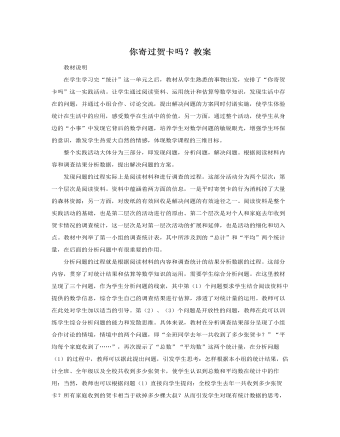
人教版新课标小学数学四年级上册你寄过贺卡吗?教案
整个实践活动大体分为三部分,即发现问题,分析问题,解决问题。根据阅读材料内容和调查结果分析数据,提出解决问题的方案。发现问题的过程实际上是阅读材料和进行调查的过程。这部分活动分为两个层次:第一个层次是阅读资料。资料中蕴涵着两方面的信息,一是平时寄贺卡的行为消耗掉了大量的森林资源;另一方面,对废纸的有效回收是解决问题的有效途径之一。阅读资料是整个实践活动的基础,也是第二层次的活动进行的原由。第二个层次是对个人和家庭去年收到贺卡情况的调查统计,这一层次是对第一层次活动的扩展和延伸,也是活动的细化和切入点。教材中列举了第一小组的调查统计表,其中所涉及到的“总计”和“平均”两个统计量,在后面的分析问题中有很重要的作用。分析问题的过程就是根据阅读材料的内容和调查统计的结果分析数据的过程。这部分内容,贯穿了对统计结果和估算等数学知识的运用,需要学生综合分析问题。
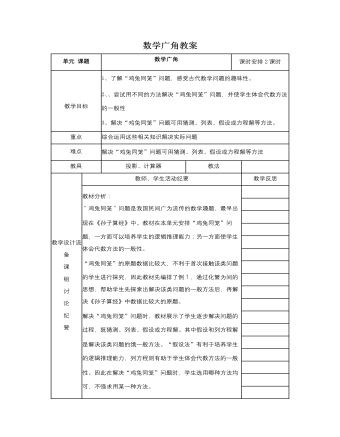
人教版新课标小学数学六年级上册数学广角教案
教材分析:"鸡兔同笼"问题是我国民间广为流传的数学趣题,最早出现在《孙子算经》中。教材在本单元安排“鸡兔同笼”问题,一方面可以培养学生的逻辑推理能力;另一方面使学生体会代数方法的一般性。“鸡兔同笼”的原题数据比较大,不利于首次接触该类问题的学生进行探究,因此教材先编排了例1,通过化繁为间的思想,帮助学生先探索出解决该类问题的一般方法后,再解决《孙子算经》中数据比较大的原题。解决“鸡兔同笼”问题时,教材展示了学生逐步解决问题的过程,既猜测、列表、假设或方程解。其中假设和列方程解是解决该类问题的饿一般方法。“假设法”有利于培养学生的逻辑推理能力,列方程则有助于学生体会代数方法的一般性。因此在解决“鸡兔同笼”问题时,学生选用哪种方法均可,不强求用某一种方法。
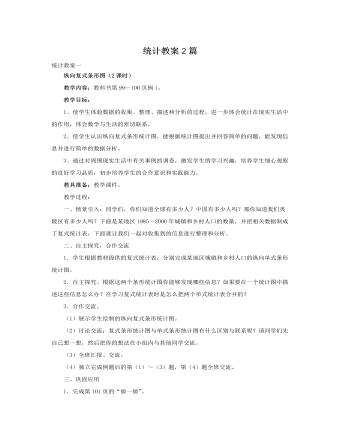
人教版新课标小学数学四年级上册统计教案2篇
教学目标:1、经历简单的收集、整理、描述和分析数据的过程。2、使学生初步了解数据的收集和整理过程,学会整理简单的数据,会看简单的统计表和统计图,会根据统计图表中的数据回答一些简单的问题。3、使学生体验解数据的收集、整理、描述和分析的过程,能发现信息并进行简单的数据分析。4、体会到数学知识与实际生活紧密联系,激发学生的学习兴趣,培养学生细心观察的良好学习品质。教学重点:绘制纵向复式条形统计图。教学难点:根据统计图发现问题、提出问题、解决问题。教具准备:课件。教学过程:一、情境导入:你们知道全球有多少人?中国有多少人吗?那你们知道自己所在的区有多少人吗?下面我们一起对收集到的信息进行整理和分析。二、探究新知:1、根据统计表,分别完成两个单式条形统计图2、根据两个条形统计图你能发现哪些信息?如果要在一个统计图中描述这些信息怎么办?在学习复式统计表时是怎么把两个单式统计表合并的?
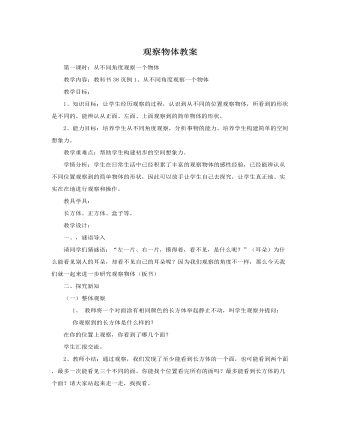
人教版新课标小学数学五年级上册观察物体教案
第一课时:从不同角度观察一个物体教学内容:教科书38页例1、从不同角度观察一个物体教学目标:1、知识目标:让学生经历观察的过程,认识到从不同的位置观察物体,所看到的形状是不同的。能辨认从正面、左面、上面观察到的简单物体的形状。2、能力目标:培养学生从不同角度观察,分析事物的能力。培养学生构建简单的空间想象力。教学重难点:帮助学生构建初步的空间想象力。学情分析:学生在日常生活中已经积累了丰富的观察物体的感性经验,已经能辨认从不同位置观察到的简单物体的形状,因此可以放手让学生自己去探究,让学生真正地、实实在在地进行观察和操作。教具学具:长方体、正方体、盒子等。教学设计:一、,谜语导入请同学们猜谜语:“左一片、右一片,摸得着,看不见,是什么呢?”(耳朵)为什么能看见别人的耳朵,却看不见自己的耳朵呢?因为我们观察的角度不一样,那么今天我们就一起来进一步研究观察物体(板书)
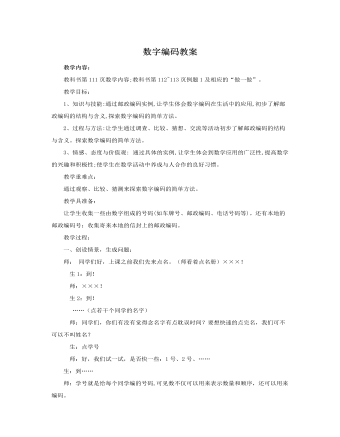
人教版新课标小学数学五年级上册数字编码教案
2、互动交流,探究规律。 (1)、小组内交流讨论: 让每个同学说出自己的发现,说说自己的猜想,并讨论邮政编码中的数字是怎样编排的。(师巡视,随机参与讨论。) (2)、全班展示交流: 师:那个小组愿意先来展示一下你们的探究结果? 生1:我们发现邮政编码都是由6个数字组成的。…… 生2:我们发现前两位数字表示省,如…… 生3:同一个省、市的邮政编码前三位数字相同。比如……。 (让学生充分发言) 【设计意图:“自主探索——互动交流——汇报展示”,充分展现学生自主探究的过程,突出了学生的主体地位,培养了学生自主获取知识的能力和合作交流的意识。】 3、共同优化,形成结论。 (1) 教师配合多媒体课件说明邮政编码的结构和组成: 师:我国邮政编码的结构与含义采用“四级六位制”。编码含义:邮政编码的六位数字分别代表了省、市、邮政、县市、投递局四级单位。其中:前二位表示省(自治区、直辖市);前三位表示邮区;前四位表示县(市);最后两位表示投递局(所)
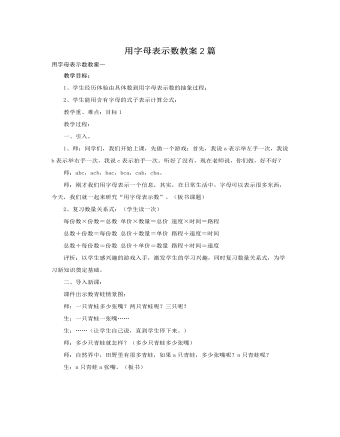
人教版新课标小学数学五年级上册用字母表示数教案2篇
教学目标:1、学生经历体验由具体数到用字母表示数的抽象过程;2、学生能用含有字母的式子表示计算公式;教学重、难点:目标1教学过程:一、引入。1、师:同学们,我们开始上课,先做一个游戏:首先,我说a表示举左手一次,我说b表示举右手一次,我说c表示拍手一次。听好了没有,现在老师说,你们做,好不好?师:abc,acb,bac,bca,cab,cba。师:刚才我们用字母表示一个信息,其实,在日常生活中,字母可以表示很多东西,今天,我们就一起来研究“用字母表示数”。(板书课题)2、复习数量关系式:(学生读一次)每份数×份数=总数 单价×数量=总价 速度×时间=路程总数÷份数=每份数 总价÷数量=单价 路程÷速度=时间总数÷每份数=份数 总价÷单价=数量 路程÷时间=速度评析:以学生感兴趣的游戏入手,激发学生的学习兴趣,同时复习数量关系式,为学习新知识奠定基础。

